Early Wednesday morning, September 20, while walking the Scenic Loop at Tyler before the weekly bird walk, I spotted an immature Broad-winged Hawk perched high atop a bare tree. It was taking in the warm light of the rising sun.
A few minutes later I came across another broad-wing, this time an adult, basking itself high atop Tyler’s iconic Giant Sequoia. Later, just before 10 am on the weekly bird walk, the birders began spotting Broad-winged Hawks rising into the sky from the surrounding trees. Within a half hour we had counted twenty-eight broad-wings over the arboretum! What was happening?
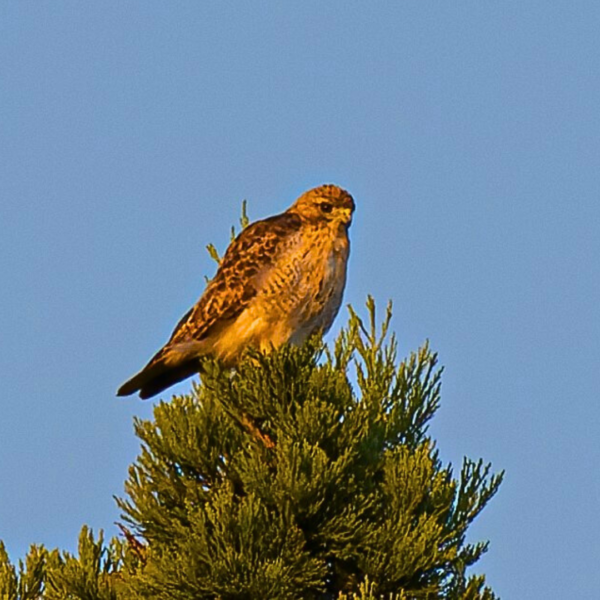
Taking a rest before heading south.
What is a Broad-Winged Hawk?
Broad-winged Hawks are not an uncommon species. Broad-wings breed in the deciduous and mixed forests of eastern and central North America. They are classified as complete migrants. That means the entire population, with rare exception, migrates to wintering grounds in southern Mexico, Central and South America.
With the help of data collated from a nationwide network of hawk watches largely conducted by volunteer citizen scientists, researchers have obtained a fairly precise understanding of how climate, weather and topography combine to drive hawk migration.
Broad-winged Hawks are one of the few species of North American raptors that migrate in flocks. This makes finding the next thermal a group effort. Once a thermal is located the birds gather in a flock, sometimes numbering in the thousands.
Hawk watchers refer to a group of raptors rising on a thermal as a “kettle” because the birds resemble bubbles rising in a boiling kettle.
When the birds stream out from the top of the thermal they do so either in a line, one following the other, or in broad phalanxes that resemble squadrons of airplanes. It is quite a sight to behold.
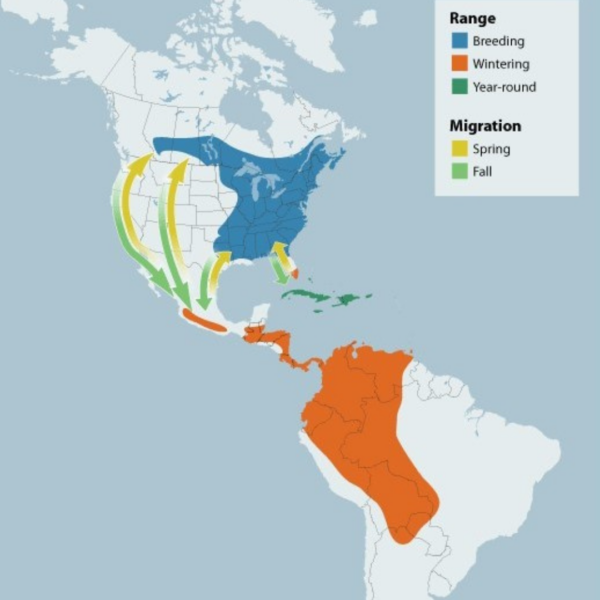
A comprehensive look at the broad-winged hawk's migration pattern.
Fickle Flyers
Broad-wings don’t like to fly over big bodies of water. Why? Because there are no thermals rising from the cool water and no ridges providing uplift.
Cape May gets high numbers of broad-wings because migrating hawks follow the coastline until they run into the Delaware Bay. Here they pause until they find a route across the bay that suits them.
This aversion to water also explains a phenomenon seen in Texas, Mexico and Central America. Remember, Broad-winged Hawks are complete migrants. That means every Broad-winged Hawk, along with other migrating raptor species, funnel down through Texas into Mexico on their way to their wintering grounds. This happens within a small time window and over a very narrow land mass.
Millions of broad-wings fly overhead in a season. It’s a spectacle widely known as the River of Raptors.
This concentration of birds necessarily creates flocks and kettles of raptors that number in the tens and even hundreds of thousands in a day.
Perfect Conditions for Migration
Wednesday’s weather featured clear skies and rapid warming thanks to a bright sun. It was our third consecutive day under the influence of northwesterly winds. It was the twentieth of September. These were all perfect conditions for a big push of migrating Broad-winged Hawks.
On Tuesday, counters at the Rose Tree Park Hawk Watch in Media had tallied 661 migrating Broad-winged Hawks. This day, Wednesday, was to bring 2,656 broad-wings followed by 1,353 on Thursday. These were uncommonly good daily counts for RTPHW but, given the weather conditions and date, not all that surprising and actually fairly predictable.
Broad-wings are masters at the art of soaring. Under favorable conditions, they can migrate long distances while expending very little energy.
To accomplish this they take advantage of rising columns of warm air known as thermals. They rise in a thermal in tight circles with their wings spread and little or no flapping. When the lift from the thermal dissipates they glide out until they find another thermal on which to rise up and glide again. Depending on the wind and weather broadwings are known to cover several hundred miles in a day using this technique.
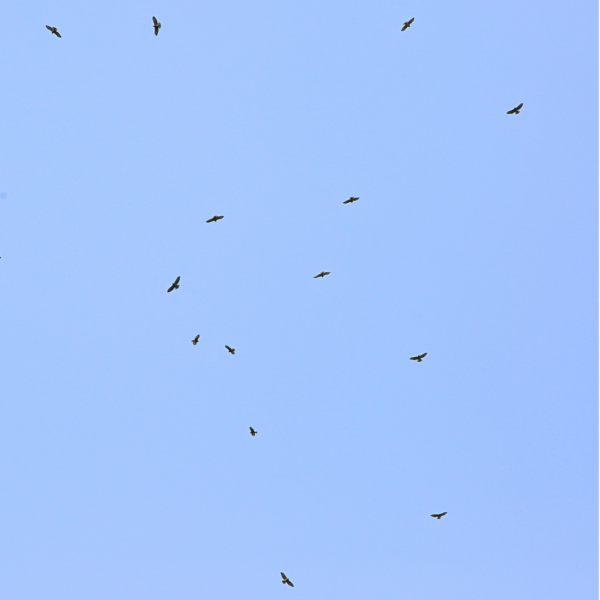
Taking advantage of the thermals.
Setting a Course for Adventure
Most of the Broad-winged Hawks that migrate through our region do so in a tight time window during the second or third week of September. The largest concentrations of migrants often occur over a three or four-day period within that window. Those two weeks in September are affectionately known as broad-wing season at Hawk Watches.
The majority of broad-wings that pass through eastern Pennsylvania follow the Kittatinny Ridge to our west. This is where venerable hawk-watching sites like Hawk Mountain and Waggoner’s Gap are located.
The ridges offer an advantage because the prevailing westerly winds push air up the western slope of the mountains providing lift. These winds are a more consistent source of lift than thermals which can be fickle here in the flatlands.
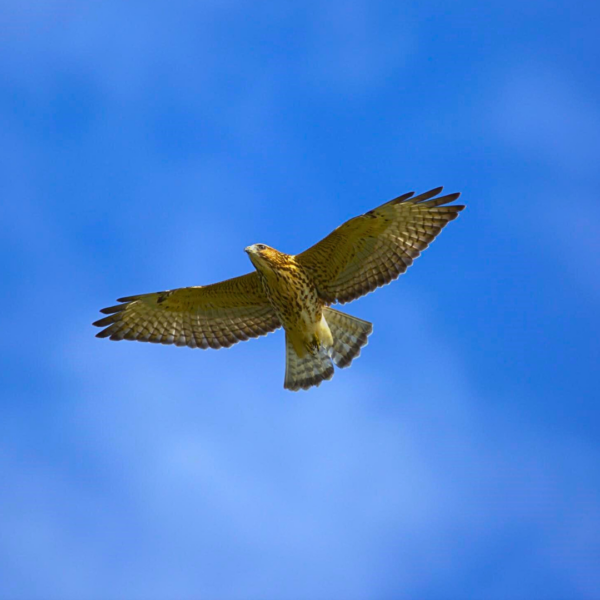
Soaring over the land.
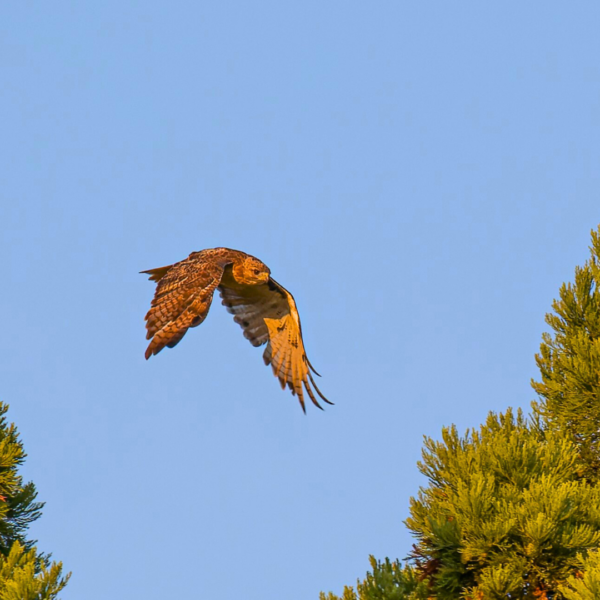
Good luck on your journey!
Photographs courtesy of David Eberly and John Mercer
You Know What They Say about the Early Bird…
So, what the weekly bird walkers at Tyler witnessed that day was a morning liftoff of migrating Broad-winged Hawks from their overnight roosts. It was the third week of September, a day that was to bring clear skies, warm temperatures, and northwest winds. The birds were headed off to find thermals on which they would gather and form kettles with their fellow migrants, also rising from the surrounding woods. All to take advantage of conditions perfect for propelling them on their incredible overland journey south.
Interested in more birding events? Join us for these upcoming programs:
- Weekday Bird Walk Every Wednesday from 8:00 a.m. – 10:00 a.m. Free for members!
- Early Morning Owl Prowl November 4, 6:00 a.m. – 7:30 a.m. Members only
- Nature at Night: Birds of Prey November 8, 7:00 p.m. – 8:00 p.m. Discounted for Members






